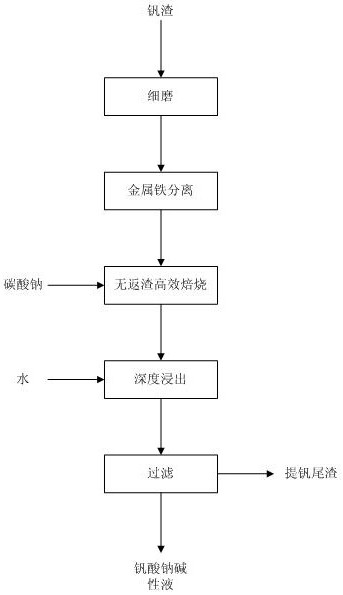Method for extracting vanadium from vanadium slag through sodium salt roasting
A technology of sodium roasting and vanadium slag, applied in the direction of improving process efficiency, etc., can solve the problems of long process, low vanadium yield, long process flow, etc.
- Summary
- Abstract
- Description
- Claims
- Application Information
AI Technical Summary
Problems solved by technology
Method used
Image
Examples
Embodiment 1
[0026] This embodiment provides a method for extracting vanadium by sodium roasting with high conversion rate without returning slag from vanadium slag, the steps are as follows:
[0027] S1. Fully grind the vanadium slag containing 10% elemental iron and 6.8% vanadium in a multi-stage vertical mill until the particle size of the vanadium slag is less than 100 microns.
[0028] S2. The obtained vanadium slag is subjected to magnetic separation to separate metallic iron to obtain vanadium slag containing 1% of elemental iron and 7% of vanadium. The number of magnetic separation stages is 3. First, a weak magnetic separation is performed, followed by two strong magnetic separations.
[0029] S3. Sodium carbonate and the vanadium slag separated from metallic iron are mixed according to the molar ratio of total vanadium and sodium carbonate in the vanadium slag being 1:0.6, and roasted in a rotary kiln at 750°C for 1.5h.
[0030] S4. The roasted vanadium slag is leached at 65°C fo...
Embodiment 2
[0033] This embodiment provides a method for extracting vanadium by sodium roasting with high conversion rate without returning slag from vanadium slag, the steps are as follows:
[0034] S1. Fully grind the vanadium slag containing 13% of elemental iron and 7% of vanadium in a multi-stage vertical mill, and crush until the particle size of the vanadium slag is less than 80 microns.
[0035] S2. The obtained vanadium slag is subjected to magnetic separation to separate metallic iron to obtain vanadium slag containing 0.8% of elemental iron and 7.5% of vanadium. The number of magnetic separation stages is 3. First, a weak magnetic separation is performed, followed by two strong magnetic separations.
[0036] S3. Sodium carbonate and vanadium slag after separation of metal iron are carried out in a rotary kiln at 800° C. for 2 hours according to the molar ratio of total vanadium and sodium carbonate in the vanadium slag being 1:0.65.
[0037] S4. Add water to the roasted vanadiu...
Embodiment 3
[0040] This embodiment provides a method for extracting vanadium by sodium roasting with high conversion rate without returning slag from vanadium slag, the steps are as follows:
[0041] S1. Fully grind the vanadium slag containing 15% elemental iron and 6.7% vanadium in a multi-stage vertical mill until the particle size of the vanadium slag is less than 90 microns.
[0042] S2. The obtained vanadium slag is subjected to magnetic separation to separate metallic iron to obtain a vanadium slag containing 0.9% of elemental iron and 7.2% of vanadium. The number of magnetic separation stages is 4. First, carry out two weak magnetic separations, and then carry out two strong magnetic separations .
[0043] S3. Sodium carbonate and the vanadium slag after separation of metallic iron are carried out in a rotary kiln at 800° C. for 2.5 hours according to the molar ratio of total vanadium and sodium carbonate in the vanadium slag being 1:0.65.
[0044] S4. Add water to the roasted va...
PUM
| Property | Measurement | Unit |
|---|---|---|
| particle size | aaaaa | aaaaa |
Abstract
Description
Claims
Application Information
 Login to View More
Login to View More - R&D
- Intellectual Property
- Life Sciences
- Materials
- Tech Scout
- Unparalleled Data Quality
- Higher Quality Content
- 60% Fewer Hallucinations
Browse by: Latest US Patents, China's latest patents, Technical Efficacy Thesaurus, Application Domain, Technology Topic, Popular Technical Reports.
© 2025 PatSnap. All rights reserved.Legal|Privacy policy|Modern Slavery Act Transparency Statement|Sitemap|About US| Contact US: help@patsnap.com

